Tag: 3d-printing
-
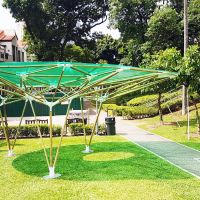 Felix Amtsberg's Bamboo Pavillion "Sombra Verde" opened in Singapore2018-05-09, Tags: 3d-printing additive-manufacturing digital-manufacturing fabrication
Felix Amtsberg's Bamboo Pavillion "Sombra Verde" opened in Singapore2018-05-09, Tags: 3d-printing additive-manufacturing digital-manufacturing fabricationThe bamboo pavilion “Sombra Verde” combines digital fabrication technology (I.E. 3D-printing) with natural grown resources in a spatial grid structure. Visual sensing digitizes the section geometry of each bamboo pole, which is used in two ways.
-
The bamboo poles are placed according their load-carrying capacity
-
The specific section geometry informs the digital model to fabricate a bespoke dowel system
Conventional 3D-Printers on PLA base materialize the 36 joints and 234 connectors using eco-friendly PLA and merge natural and "digital" materiality.
The project, which was developed and designed by Felix Amtsberg, Felix Raspall and Carlos Banon of AIRLab, can be visited in Duxton Plain Park until the 15th of June.
-
-
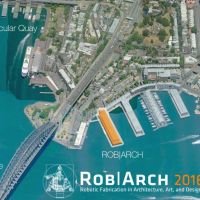 Mark Tam and Caitlin Mueller present at RobArch 2016 in Sydney2016-03-18, Tags: fabrication 3d-printing additive-manufacturing principal-stress-lines
Mark Tam and Caitlin Mueller present at RobArch 2016 in Sydney2016-03-18, Tags: fabrication 3d-printing additive-manufacturing principal-stress-linesDigital Structures are at the 3rd Robotics in Architecture conference in Sydney, Australia to share their work on robotics-enabled stress line additive manufacturing, a new 3D printing technique that deposits material along lines of force flow for enhanced structural performance.
-
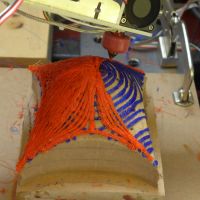 3D Printed Structures: Challenges and OpportunitiesCaitlin Mueller, STRUCTURE, 2016
3D Printed Structures: Challenges and OpportunitiesCaitlin Mueller, STRUCTURE, 2016Technologies for 3D printing, or more broadly additive manufacturing, have proliferated in recent years, and have captured the public’s imagination as a revolutionary way to democratize small-scale, customized manufacturing for the DIY community. In the design of buildings and bridges, 3D printing has proven to be a valuable technique for creating intricately detailed scale models in a fraction of the time required by traditional methods. In both cases, the generalized layer-by-layer material deposition process is a compelling way to achieve geometries of nearly infinite complexity with ease. But 3D printing has also permeated markets beyond the consumer and model scale, with increasing buzz about applying the technology to large objects, such as full-scale buildings. This prospect is exciting for several reasons: reduced construction waste through highly precise material placement, increased capacity for complex geometries for both functional and aesthetic purposes, and new possibilities for integrating building component functions into a single, streamlined assembly. Looking forward, it is clear that many challenges lie ahead before the promise of 3D printing can be broadly achieved for building structures, but the recent, rapid development of increasingly realistic proofs-of-concept is highly encouraging. The continued contributions of pioneering structural engineers are critical to help push this transformative technology from small-scale geometric representation to high-performance, full-scale structures.
-
 Interplanetary Architecture article and video feature Ouroboros Martian Habitat2015-10-15, Tags: mars 3d-printing
Interplanetary Architecture article and video feature Ouroboros Martian Habitat2015-10-15, Tags: mars 3d-printingA recent MIT News article discussed the Digital Structures' Villa Ouroboros proposal for additively manufactured habitats on Mars. An accompanying video that shows more of the team's proposal is also included.
-
 Digital Structures heads to World Maker Faire in NYC2015-09-25, Tags: fabrication 3d-printing additive-manufacturing mars composites
Digital Structures heads to World Maker Faire in NYC2015-09-25, Tags: fabrication 3d-printing additive-manufacturing mars compositesMitchell Gu, Caitlin Mueller, and team head to NYC as finalists in the NASA 3D Printed Habitat Challenge at the World Maker Faire. Our submission includes a 3D-printed model that makes use of four different additive manufacturing strategies, including a heat-formed thermoplastic composite shell.
-
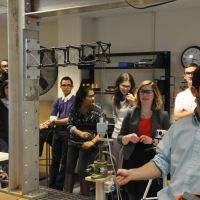 1.013: Senior Civil and Environmental Engineering DesignClass, 2014
1.013: Senior Civil and Environmental Engineering DesignClass, 2014As part of their senior capstone design class in Civil and Environmental Engineering, students completed a 3-week exercise to design, fabricate, and test a scale prototype of a sensor tower, with the goals of minimizing cost and embodied carbon while meeting strength and deflection performance goals. Students designed their towers with the help of hand calculations and digital tools, including structureFIT and commercial structural analysis software. They selected materials from a catalog of options that included steel, aluminum, wood, carbon fiber, FRP, and 3D-printed ABS plastic, with a focus on tradeoffs between cost and structural performance. Fabrication of physical prototypes involved a combination of traditional and digital making techniques, with an emphasis on connections and interfaces between materials. Finally, the structures were load tested to investigate failure modes and reveal differences between calculated and actual performance.
-
 Structural lattice additive manufacturingResearch, 2015 - Present
Structural lattice additive manufacturingResearch, 2015 - PresentThe structural performance of traditional 3D-printed parts is typically limited by nature of the ayer-by-layer construction. Such parts are anisotropic due to decreased adhesion between layers and the internal structure is uniform, not flexible. This project seeks to overcome these limitations by printing along the edges of a stress-optimized lattice. With this approach, larger-scale, lightweight parts can be printed with an optimal structure that can vary depending on a loading configuration. The results of this project may be promising for diverse fields including concrete rebar design, spaceframe prototyping for buildings, and generative art.
The fabrication component of the project includes designing a custom extruder for a six-axis robotic arm that excels in printing along hard-to-reach toolpaths in free air, with larger nozzle diameters. To complement this technology, a computational tool is in development to generate lattices and toolpaths for any part and its loading configuration.
-
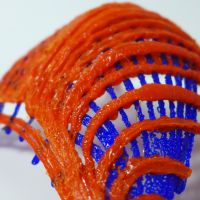 Stress line additive manufacturing (SLAM)Research, 2014 - 2015
Stress line additive manufacturing (SLAM)Research, 2014 - 2015The project presents a new integrated software and hardware process that reconsiders the traditional addive manufacturing (AM) technique of fused deposition modelling (FDM) by adding material explicitly along the three-dimensional principal stress trajectories, or stress lines, of 2.5-D structural surfaces. Using a six-axis robotic arm, this project materializes continuous stress fields into discrete structural topologies, rendered computationally as robotic tool paths. The goal of this project is to develop and perfect this new technique, and to explore conditions in which it is favorable to conventional layer-based additive manufacturing. The research is supported by methodologies including computational structural analysis and comparative structural load testing. For more video information, see this YouTube video.


